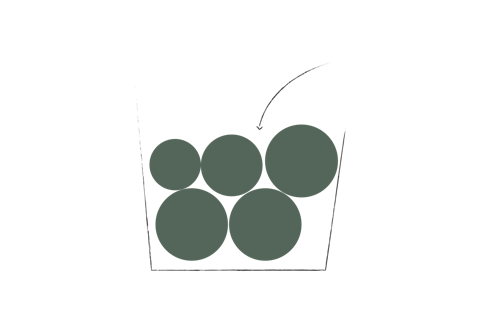How Incrementality Will Help You Make Better Budget Decisions
February 19, 2020

More than just a buzzword, incrementality is instrumental to both advertisers and partners. Many talk about it; many see the value in it. And few are willing to embrace it correctly. Still, it is important to reiterate its importance as a way of understanding the real value of your paid efforts. Relying on attribution alone gives us an incomplete view. Therefore we can rely on incrementality to provide a clearer picture of your retargeting results.
What can incrementality do for you?
Incrementality is the right approach to measure your organic baseline as a way to accurately know how effective your retargeting campaigns are. Incrementality measurement allows you to improve your ROAS continuously by optimizing campaigns towards true uplift.
The ages-old question of finding out how many of your conversions are organic versus the ones that are brought forth by paid efforts has been analyzed from a constrained attribution point of view. And attribution modeling as we know it is no longer enough to provide the precise answers the modern mobile marketer needs.
There is a need to set measuring practices and KPIs that reflect the incremental value brought by campaigns (a move towards incremental ROAS, so to speak) and to distinguish those from the organic activity in your app.
Do you know your organic baseline?
The main area where a truly incremental approach assists performance marketers is one of knowledge. To know if your retargeting strategy has the intended effects, you need to know the absolute contribution of your campaigns to an uplift in conversions and revenue. This implies that you also know what your organic baseline is - how many conversions and consequent revenue are happening organically and through all other marketing activities - and what is the weight of this organic behavior and the other activities in your marketing mix.
We consider “organic baseline” from a holistic point of view. For the sake of accurate incrementality measurement, the control group will include all conversions and revenue generated from organic installs and viral effects, plus conversions and revenue made as a result of other marketing activities, including UA campaigns, TV ads, and other types of offline campaigns.
Measuring through an incrementality standpoint will lead you to assess the true value of your campaigns, including which campaigns were most effective, which ones generated more revenue.
The incrementality approach is also the solution to your cannibalization worries. If there were still doubts that retargeting campaigns might be eating away your organic conversions, incrementality measurement works by providing more transparency on your uplift potential. This is the valuable info that will allow you to gather insights about the audience and campaigns to optimize not only your retargeting efforts but your entire paid strategy.
Incrementality leads to successful retargeting
Incrementality is all about proving real impact. This advanced measurement is the way forward when it comes to retargeting as it provides accurate and actionable data that is clear to interpret. Some clients using incrementality along with their retargeting campaigns report results up to 60% increased conversion rates and ROAS > 300%, proving that the investments in retargeting were able to bring incremental active users that drive real value.
As a result, incrementality measurement and its insights drive advertisers to realign the KPIs set for retargeting, and generate more value throughout their user segments.
And, the good news is that, as an advertiser, you don’t need much to run incrementality testing. The requirements to run incremental retargeting campaigns are clear:
- Your partner will need access to a complete event stream from your app (SDK-less integration via MMP, for example) to be able to measure the organic baseline;
- The advertiser must put efforts in developing personalized creatives that drive higher levels of re-engagement;
- Don’t forget deep links/universal links, that lead users directly to content pages and drive better performance;
- The advertiser needs a sufficient test budget suitable to the audience size to run a campaign (Note: there are no costs for the control group.);
- Last but not least, advertisers are advised to educate themselves about the different methodologies and discuss with the retargeting partner what their approach is.
How does Remerge go about incrementality?
One of the factors of resistance to incrementality is its level of complexity. When it comes to deciding the best way to approach it, we dive into a sea of scientific measurement methodologies. It is a complex subject; this is a fact. But it doesn’t need to be complicated. When it comes to the “right methodology,” we can narrow it down to a few approaches explained here.
The right methodology is one that can address these four priorities that are relevant to retargeting:
1) it should include a clean control group that accounts for organic behavior and the other marketing activities run by the advertiser;
2) be easily verifiable by the advertiser;
3) be aligned with the KPI and business goals of the client;
4) and, most importantly, be able to be implemented continuously and free of cost for the advertiser.
Remerge uses a “Ghost Bids” approach that offers benefits when compared with methodologies such as ITT and PSA. Similar to the Ghost Ads, this concept provides a more solid measurement, low noise, and lowest selection bias with the further advantage of being free of cost for the advertiser. This methodology ensures the significance and accuracy of the results and allows the advertiser to access the raw data to extract further insights if needed.
Recap
When it comes to the real impact of your retargeting campaigns, advertisers need to prove it in revenue uplift, not clicks. How you measure that uplift makes a world of difference to the success of your strategy. After all, nobody wants to spend their budgets blindly. Mobile marketers need certainties, and incrementality measurement provides the insights needed to find the link between your retargeting efforts and increased ROAS. Use incrementality to your advantage and pave the way to future and sustainable app growth.





